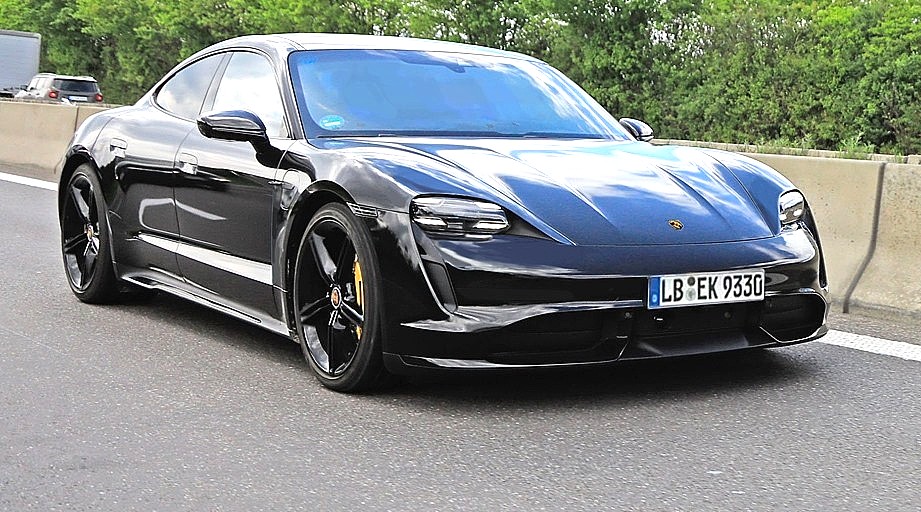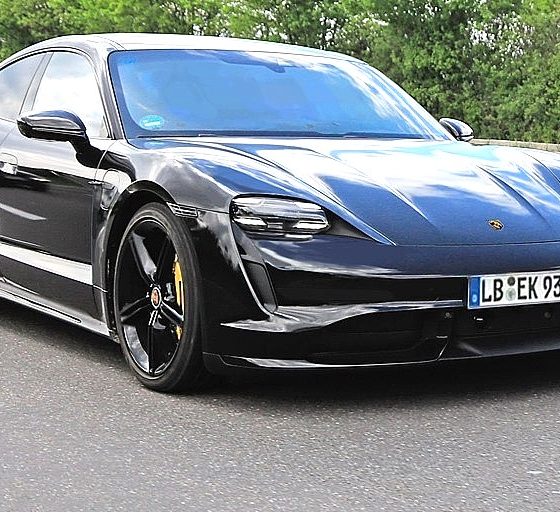

News
Porsche Taycan debut set for September 4, top facts about upcoming sports EV emerge
Porsche has confirmed that the formal debut of its first modern all-electric car, the Taycan, is set for September 4, 2019 at 9 a.m. EST. The vehicle will be launched at three locations: one in Canada, one in Germany, and another in China. With the Taycan’s launch, Porsche would be breaching a premium EV market that is so far dominated by Tesla and increasingly populated by veteran automakers such as Jaguar, Audi, and Mercedes-Benz.
The Taycan’s unveiling is only a few weeks away, and Porsche has been notably more open about giving access to its highly-secretive vehicle to the media. So far, the vehicle has been received extremely well. Fifth Gear presenter and Fully Charged host Jonny Smith, for one, was allowed to test the repeatability of the Taycan Turbo’s maximum performance during launches. The vehicle proved impressive for the host, as he was able to launch at max power 26 times with nary a drop in the car’s 0-60 mph performance.
Motoring publication Car and Driver was also able to experience the Porsche Taycan Turbo. Together with Porsche product line director for EVs Robert Meier, the publication was able to get some unique insights on the upcoming vehicle. The Taycan pre-production prototype, behind all its camouflage, was equipped with active anti-roll bars, carbon-ceramic brake rotors, rear-wheel steering, air springs, and a 21″ wheel and tire setup.
During Car and Driver‘s ride-along, Meier noted that the Taycan, thanks to its floor-mounted battery pack, actually has the lowest center of gravity in the company’s entire lineup. Comfort was a key portion of the Taycan’s development process as well, considering that the vehicle will be marketed as a four-door sedan that’s a step beneath the Panamera (and in turn, the Tesla Model S) in size. Highlighting the Taycan’s quickness, the Porsche executive noted that the vehicle will not see a drop in performance even when the battery is discharged past 50%.
Also notable is that the Taycan, unlike Tesla’s offerings like the Model 3 Performance, features a two-speed gearbox on its rear axle. This marks one of the first times that a production EV will be equipped with a two-speed gearbox, and it should provide a sizable benefit in both performance and efficiency. It would be interesting to see how Porsche manages the Taycan’s gearbox, considering Tesla’s experience with the original Roadster. During Tesla’s early days, the company equipped the original Roadster with a two-speed gearbox, but the components just kept breaking since the gearboxes could not handle the punishment from the vehicle’s electric motor.
Porsche states that the Taycan will have a range of 500 km (311 miles), though Car and Driver notes that this figure is based on the European NEDC cycle, which is far more generous than the more stringent and real-world accurate EPA cycle. During its ride-along with the vehicle, the publication noted that the Taycan showed a predicted 234 miles of range on a full charge, which reportedly seemed accurate considering that the trip’s route consisted of twisty mountain roads and 70-mph highway cruising. Meier’s comments to the publication’s team about being “conservative” with the Taycan’s range figure further adds to the idea of the vehicle having a US range rating that’s likely closer to 200 than 300 miles.
The Taycan has other notable quirks, including, but not limited to, two charging ports, its lack of one-pedal driving, and its sound, which could be heard especially at low speeds. This was particularly audible during Fully Charged host Jonny Smith’s first drive of the vehicle. With its low, bass-filled whine, the Taycan sounds not unlike those futuristic vehicles in sci-fi films.
Watch Fully Charged‘s experience with the Porsche Taycan Turbo in the video below.

Elon Musk
Elon Musk’s X will start using a Tesla-like software update strategy
The initiative seems designed to accelerate updates to the social media platform, while maintaining maximum transparency.

Elon Musk’s social media platform X will adopt a Tesla-esque approach to software updates for its algorithm.
The initiative seems designed to accelerate updates to the social media platform, while maintaining maximum transparency.
X’s updates to its updates
As per Musk in a post on X, the social media company will be making a new algorithm to determine what organic and advertising posts are recommended to users. These updates would then be repeated every four weeks.
“We will make the new 𝕏 algorithm, including all code used to determine what organic and advertising posts are recommended to users, open source in 7 days. This will be repeated every 4 weeks, with comprehensive developer notes, to help you understand what changed,” Musk wrote in his post.
The initiative somewhat mirrors Tesla’s over-the-air update model, where vehicle software is regularly refined and pushed to users with detailed release notes. This should allow users to better understand the details of X’s every update and foster a healthy feedback loop for the social media platform.
xAI and X
X, formerly Twitter, has been acquired by Elon Musk’s artificial intelligence startup, xAI last year. Since then, xAI has seen a rapid rise in valuation. Following the company’s the company’s upsized $20 billion Series E funding round, estimates now suggest that xAI is worth tens about $230 to $235 billion. That’s several times larger than Tesla when Elon Musk received his controversial 2018 CEO Performance Award.
As per xAI, the Series E funding round attracted a diverse group of investors, including Valor Equity Partners, Stepstone Group, Fidelity Management & Research Company, Qatar Investment Authority, MGX, and Baron Capital Group, among others. Strategic partners NVIDIA and Cisco Investments also continued support for building the world’s largest GPU clusters.
News
Tesla FSD Supervised wins MotorTrend’s Best Driver Assistance Award
The decision marks a notable reversal for the publication from prior years, with judges citing major real-world improvements that pushed Tesla’s latest FSD software ahead of every competing ADAS system.

Tesla’s Full Self-Driving (Supervised) system has been named the best driver-assistance technology on the market, earning top honors at the 2026 MotorTrend Best Tech Awards.
The decision marks a notable reversal for the publication from prior years, with judges citing major real-world improvements that pushed Tesla’s latest FSD software ahead of every competing ADAS system. And it wasn’t even close.
MotorTrend reverses course
MotorTrend awarded Tesla FSD (Supervised) its 2026 Best Tech Driver Assistance title after extensive testing of the latest v14 software. The publication acknowledged that it had previously criticized earlier versions of FSD for erratic behavior and near-miss incidents, ultimately favoring rivals such as GM’s Super Cruise in earlier evaluations.
According to MotorTrend, the newest iteration of FSD resolved many of those shortcomings. Testers said v14 showed far smoother behavior in complex urban scenarios, including unprotected left turns, traffic circles, emergency vehicles, and dense city streets. While the system still requires constant driver supervision, judges concluded that no other advanced driver-assistance system currently matches its breadth of capability.
Unlike rival systems that rely on combinations of cameras, radar, lidar, and mapped highways, Tesla’s FSD operates using a camera-only approach and is capable of driving on city streets, rural roads, and freeways. MotorTrend stated that pure utility, the ability to handle nearly all road types, ultimately separated FSD from competitors like Ford BlueCruise, GM Super Cruise, and BMW’s Highway Assistant.
High cost and high capability
MotorTrend also addressed FSD’s pricing, which remains significantly higher than rival systems. Tesla currently charges $8,000 for a one-time purchase or $99 per month for a subscription, compared with far lower upfront and subscription costs from other automakers. The publication noted that the premium is justified given FSD’s unmatched scope and continuous software evolution.
Safety remained a central focus of the evaluation. While testers reported collision-free operation over thousands of miles, they noted ongoing concerns around FSD’s configurable driving modes, including options that allow aggressive driving and speeds beyond posted limits. MotorTrend emphasized that, like all Level 2 systems, FSD still depends on a fully attentive human driver at all times.
Despite those caveats, the publication concluded that Tesla’s rapid software progress fundamentally reshaped the competitive landscape. For drivers seeking the most capable hands-on driver-assistance system available today, MotorTrend concluded Tesla FSD (Supervised) now stands alone at the top.
News
Elon Musk’s Grokipedia surges to 5.6M articles, almost 79% of English Wikipedia
The explosive growth marks a major milestone for the AI-powered online encyclopedia, which was launched by Elon Musk’s xAI just months ago.

Elon Musk’s Grokipedia has grown to an impressive 5,615,201 articles as of today, closing in on 79% of the English Wikipedia’s current total of 7,119,376 articles.
The explosive growth marks a major milestone for the AI-powered online encyclopedia, which was launched by Elon Musk’s xAI just months ago. Needless to say, it would only be a matter of time before Grokipedia exceeds English Wikipedia in sheer volume.
Grokipedia’s rapid growth
xAI’s vision for Grokipedia emphasizes neutrality, while Grok’s reasoning capabilities allow for fast drafting and fact-checking. When Elon Musk announced the initiative in late September 2025, he noted that Grokipedia would be an improvement to Wikipedia because it would be designed to avoid bias.
At the time, Musk noted that Grokipedia “is a necessary step towards the xAI goal of understanding the Universe.”
Grokipedia was launched in late October, and while xAI was careful to list it only as Version 0.1 at the time, the online encyclopedia immediately earned praise. Wikipedia co-founder Larry Sanger highlighted the project’s innovative approach, noting how it leverages AI to fill knowledge gaps and enable rapid updates. Netizens also observed how Grokipedia tends to present articles in a more objective manner compared to Wikipedia, which is edited by humans.
Elon Musk’s ambitious plans
With 5,615,201 total articles, Grokipedia has now grown to almost 79% of English Wikipedia’s article base. This is incredibly quick, though Grokipedia remains text-only for now. xAI, for its part, has now updated the online encyclopedia’s iteration to v0.2.
Elon Musk has shared bold ideas for Grokipedia, including sending a record of the entire knowledge base to space as part of xAI’s mission to preserve and expand human understanding. At some point, Musk stated that Grokipedia will be renamed to Encyclopedia Galactica, and it will be sent to the cosmos.
“When Grokipedia is good enough (long way to go), we will change the name to Encyclopedia Galactica. It will be an open source distillation of all knowledge, including audio, images and video. Join xAI to help build the sci-fi version of the Library of Alexandria!” Musk wrote, adding in a later post that “Copies will be etched in stone and sent to the Moon, Mars and beyond. This time, it will not be lost.”








